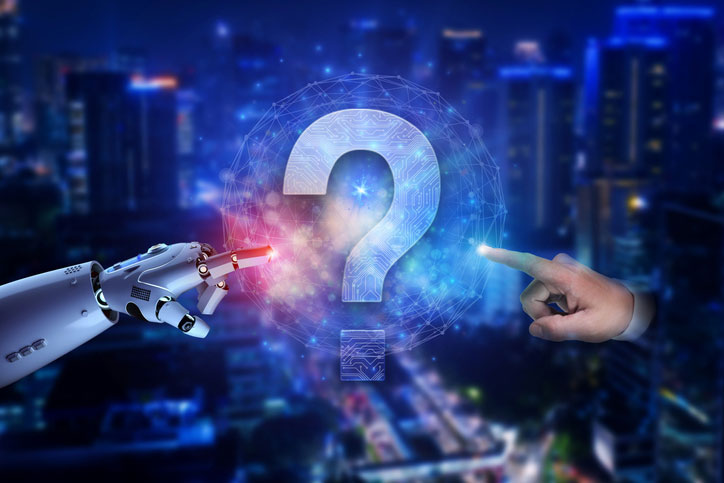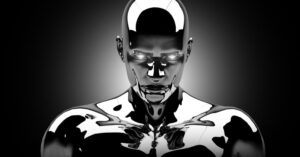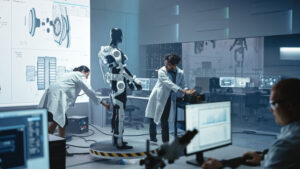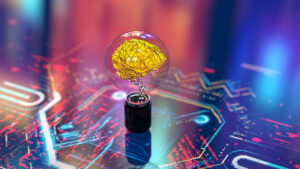Written by Scott Wilson
Artificial intelligence is the overarching field of study and development that seeks to 1) understand factors involved in human reasoning and 2) to build machines that can replicate and ultimately exceed human abilities in logic and decision-making. AI differs from existing machine logic by integrating more capabilities in assessment, judgement, and problem-solving.

If ever there was a technology that comes into the public eye fully primed for instant understanding, it’s AI. Artificial intelligence is a term that has lived in our shared imagination for decades longer than it has existed as a functional, effective technology. We can’t help but associate pop culture conceptions of HAL 9000, R2D2, and the Terminator with ChatGPT, Waymo, and Midjourney.
Even before you clicked on the link that led you here, you had an idea of what artificial intelligence is.
That idea was probably wrong. But it was also probably a little bit right. AI is a big tent term today.




But what is artificial intelligence if it’s not killer robots and sentient spaceships?
Even if chat bots seem a long way from science fiction representations of sentient AI seen in the likes of C-3PO from Star Wars or Ava from Ex Machina, they do occupy spots on the same spectrum. And looking at that spectrum is the best place to start unpacking all the meaning freighted into artificial intelligence.
Today, that spectrum has come to be characterized as the long axis between weak and strong artificial intelligence.
Early Steps into Artificial Intelligence Show Potential for Real Reasoning and Problem-Solving Ability
Researchers realized early that part of the problem with defining artificial intelligence was that there is no good definition for intelligence itself. It has characteristics of:
- Sensing and integrating observations into a coherent representation of knowledge
- Engaging in reasoning skills to assess, plan, and make decisions
- Communicating and acting on the logic and judgements made
It’s entirely possible to see some echo of those abilities in even basic computer programs. But your copy of Excel is not AI.
The Answer to the Question ‘What Is AI?’ May Ultimately Be Left to Philosophers
 Some sage once observed that artificial intelligence is a term that is most often used to describe what humans can do that computers can’t. Once computers gain those abilities, the goal posts are moved.
Some sage once observed that artificial intelligence is a term that is most often used to describe what humans can do that computers can’t. Once computers gain those abilities, the goal posts are moved.
Once upon a time, a computer that could beat any human chess player would have been revered as a miracle of artificial intelligence. But when Deep Blue beat Grand Master Garry Kasparov in 1997, it was easy to see how that success was just an outgrowth of very fast computation — but not reasoning in any human sense of the world.
Similarly, while chatbots are amazing conversationalists, most of our observations revolve around things they can’t do — perform math, check facts, sense moods, form connections. They may pass the Turing test, one of the earliest definitions of AI, by being indistinguishable from a person in conversation… but they are not intelligent in our usual sense of the word.
Philosophers and scientists continue to work toward nailing down a definition of intelligence. But when and if computers genuinely gain intelligence of the type that humans have, it might not be something we even notice.
In one sense, artificial intelligence is defined as the field of study of the creation of machine intelligence. We use it in that sense across the website here, just as we might talk about biology as the study of the field of biology.
But when most people use the term artificial intelligence, what they are really talking about is the phenomenon itself. In that sense, the most honest definition might be an organism or system created by human beings that shows the characteristics of independent thought and reasoning.
 There’s no hard and fast line to draw around artificial intelligence. Basic recommendation systems like those used by Netflix and Amazon started out as elementary programming exercises in correlating movie rankings. News articles diving into those systems at the time they were created don’t even mention the words artificial intelligence.
There’s no hard and fast line to draw around artificial intelligence. Basic recommendation systems like those used by Netflix and Amazon started out as elementary programming exercises in correlating movie rankings. News articles diving into those systems at the time they were created don’t even mention the words artificial intelligence.
But over time, those algorithms become more sophisticated. Machine learning models were written; data accumulated. And at some point—no one can really point to when—they started to be described as examples of artificial intelligence.
Weak AI Describes Systems That Reason Within Narrow Parameters
Netflix recommendations are no C-3P0. But you can look at them as the very start of the spectrum of what may be classified as weak AI.
Weak, or narrow, artificial intelligence describes systems capable of developing human-like reasoning skills in a limited or specialized scope.
Weak AI mimics certain aspects of human intelligence. It may even exceed them within its own narrow window. But it’s not capable of applying reasoning ability more generally. A chatbot is really just limited to carrying on a conversation. It can’t do math, it can’t look up information, it can’t remember, for any extended period, what you’ve told it.
You don’t need to worry about handing weak AI the nuclear launch codes: the worst it can do is turn them into a limerick.
Yet even weak AI can have groundbreaking impacts on human society. Like a chatbot, a program designed to process x-rays or medical records and look for diagnostic patterns will never learn to paint a picture, sing a song, or write a novel.
But it may take tiny and imperceptible trends from a wide range of data and develop a new protein-based therapy for cancer or diagnose a brain tumor years before it might become obvious to a human expert.
Strong AI Fills Another Definition of AI That Isn’t Here Yet
 Strong, or general, AI gets more toward the sci-fi end of the spectrum.
Strong, or general, AI gets more toward the sci-fi end of the spectrum.
A general artificial intelligence (AGI) is expected to take any form of information input and address it from any angle. It should have the cognitive tools to assess and parse data just as humans do… but tremendously faster and with deeper and less fallible data storage. It will be able to learn and remember at an unfathomable pace.
Although it’s entirely theory at this stage, the expectation is that AGI could rapidly exceed human level intelligence.
Such a machine could apply that intellectual skill in almost any way. It could think thoughts we may never hold in our minds. It could solve an equation, paint a picture, and write a book… perhaps all three at the same time.
“Where Wizards Stay Up Late” is a 1996 book about the creators of the Internet… many of whom also had a hand in early explorations of artificial intelligence. But the source of the title is a poem by Pulitzer Prize-winner James Merrill, and the stanza the quote is from offers context that surely makes it a better description of artificial intelligence engineering today:
Los Alamos’ lights where wizards stay up late
(Stay in the car, forget the gate)
To save the world or end it, time will tell
Like the efforts at Los Alamos to build the bomb, the work to create true general artificial intelligence is a leap into a fateful future. Some predict a new era of peace and wealth guided by machines more fair-minded and stable than humans; others a dystopian wilderness of unaligned automatons relentlessly pursuing their own ends with no more regard for humans than humans have for ants.
What Is Artificial Intelligence Like in the World Today?
 Clearly, this is stuff to grab the imagination. But while it’s great to dream, earning a college degree in artificial intelligence today means engaging with the state of AI as it exists in today’s world.
Clearly, this is stuff to grab the imagination. But while it’s great to dream, earning a college degree in artificial intelligence today means engaging with the state of AI as it exists in today’s world.
AI is a phenomenon that is impacting technology, society, the economy, and even philosophy. To understand what it is, you need to see it from all the angles.
What Is AI in Technology?
For technology professionals, AI represents new computational techniques to improve results and productivity across a range of applications.
It’s best to look at artificial intelligence as a collection of methods and techniques that work toward implementing reasoning abilities in machine form.
For computer science professionals focused on developing new tools and advancing AI capabilities, AI is about figuring out the nuts and bolts of how to make machines think. Programs have always been linear tracks of instructions. Outside of complex decision trees, methods for coaxing genuine reasoning out of them have been mysterious. What does it mean to take in information and make a decision? And how do you implement it in cold metal and electricity?
You can get a computer to flip a coin (although true randomness is surprisingly difficult), but that’s not exactly what human decision-making looks like, either. There are elements of statistics to it, probabilities that are inherently assigned by the human brain, but it’s not purely statistical. If gut feelings are the embodiment of human decisions—and science suggests, in some form, that they might be—then creating algorithms and programs to have a gut is still one of the core challenges in artificial intelligence.
In computer science, AI is the next frontier of computational achievement. It represents a series of great obstacles in programming that are being overcome, inch by inch.
Plumbing the Mysteries of AI Offers Unique Perspectives of Definition
 AI researchers and scientists have their hands on the mind of the machine. Where others see human-like behaviors and eerie hallucinations, these experts are looking at data and statistics. They are the psychologists of the machine world, tinkering with the wiring and shaking the connections to see what will fall out.
AI researchers and scientists have their hands on the mind of the machine. Where others see human-like behaviors and eerie hallucinations, these experts are looking at data and statistics. They are the psychologists of the machine world, tinkering with the wiring and shaking the connections to see what will fall out.
This is a view of AI that is filled with code and concepts. From their seats at the top of the AI rocket ship, scientists in this area can see the stars… but also the hard path it will take to get there. Their imaginations are bringing AI to life, but their experiences are grounded in the real limitations it shows today.
This is a unique view into what AI is, but it’s still one filled with mystery and fascination. In the most advanced deep neural networks, how data is processed and how conclusions are reached is invisible even to these brilliant professionals.
What Is AI in Business and the Economy?
 For business professionals and government leaders, AI represent practical impacts on the daily lives of citizens and consumers. While the innermost theory of thinking machines is being worked out in academia and the tech industry, other AI experts are wrestling with what kind of useful tasks AI can perform. The logical basis of AI is less important than how well or poorly it can take on tasks that humans typically perform.
For business professionals and government leaders, AI represent practical impacts on the daily lives of citizens and consumers. While the innermost theory of thinking machines is being worked out in academia and the tech industry, other AI experts are wrestling with what kind of useful tasks AI can perform. The logical basis of AI is less important than how well or poorly it can take on tasks that humans typically perform.
AI in this perspective is a transformational force that will impact lives, culture, and industry. It’s a force that will require adaptation and regulation. AI will shape the future of humanity. AI engineers working in these fields will have to develop a sense not only of capabilities, but of the impacts it has on markets and individuals.
This view of AI is the one that is shifting the fastest. As the public has been exposed to tools like Midjourney, crafting impossibly real pictures from thin air, and ChatGPT, carrying on conversations better than many adults, the definition of AI has stepped out of science fiction and into everyday life. As new tools are developed to serve their needs, the answer to what AI is will change again.
The Way AI is Used Offers a Practical Understanding of What It Is
 Business and professional AI engineers see AI through a prism of possibilities. When they tinker with a generative chat program, they imagine how personalized assistants can seek out information and solve real problems for users. When they explore computer vision systems, they see traffic safety monitors, dog-walking robots, and tools for people with visual impairments.
Business and professional AI engineers see AI through a prism of possibilities. When they tinker with a generative chat program, they imagine how personalized assistants can seek out information and solve real problems for users. When they explore computer vision systems, they see traffic safety monitors, dog-walking robots, and tools for people with visual impairments.
This is a grounded, utilitarian perspective of what AI is. It takes in the impacts of thinking machines on both individuals and society at large. It sees AI as both a threat and a promise… if it is managed well by experts.
The perspective of AI through economic and social effects is what will shape the general public’s experience of this phenomenon. So these are the roles that will end up defining what AI is for most of the world.
What Is AI in Specialized Professional Industries?
 For skilled professionals in highly technical fields, artificial intelligence is a tool with great potential to help them achieve their mission. AI is a promise of new tools with more capability. From high-frequency trading to architecture and engineering, what AI means in these fields is rapid transformation to new capabilities and a reshaping of jobs around them.
For skilled professionals in highly technical fields, artificial intelligence is a tool with great potential to help them achieve their mission. AI is a promise of new tools with more capability. From high-frequency trading to architecture and engineering, what AI means in these fields is rapid transformation to new capabilities and a reshaping of jobs around them.
For experts in fields from healthcare to agriculture, AI is both a promise and a threat. Disruption from earlier technologies has mostly come to less educated, less specialized positions. But generative AI shows the potential to adapt to even highly skilled roles across industries.
Yet teaching AI to work in very sensitive, potentially dangerous positions will require a partnership. Think Princess Leia and R2D2 in Empire Strikes Back… two pros in their own areas, each reinforcing and enabling the other, born out when R2D2 fixed the hyperdrive on the Millennium Falcon allowing Leia to evade the Empire pursuers.
For professionals in these fields, artificial intelligence may come to mean such intimate partnerships. Some of the heaviest challenges in these jobs could be overcome with the use of such machines. But extra caution and expertise will be needed at every step.
The Evolving Challenges of Coming up With a Full Definition of AI
 Artificial intelligence is well on its way to becoming a buzzword. It’s being tossed around in daily conversation by people well outside the industry, and marketers in every company are eagerly slapping it on every project that involves an algorithm of some sort in hopes of attracting buzz.
Artificial intelligence is well on its way to becoming a buzzword. It’s being tossed around in daily conversation by people well outside the industry, and marketers in every company are eagerly slapping it on every project that involves an algorithm of some sort in hopes of attracting buzz.
That very process will shift the meaning in popular terms.
The term also faces a very real, and unique, definitional challenge among experts. In fact, you might even say that the field itself is defined by our inability to clearly delineate what is, and is not, intelligence. But that is a matter of philosophy.
Engineering is about applications. And applications abound for AI as it exists today. And it is certainly AI engineering that will give life to the dream of what AI could mean tomorrow.




